II.A. DISCRETE RANDOM VARIABLES
1. BINOMIAL
Requirements for a random variable to be binomial:
1. The experiment consists of "n" identical trials.
2. There are only two possible outcomes for each trial.
3. The trials are independent of one another.
4. The probability of success is the same on each of the n trials.
5. The random variable is defined as the number of successes in n trials.
The binomial theorem is:
This probability function is indeed a probability distribution
a. p and 1 - p are fractions
b. the combinatorial part need not be a fraction.
you could prove to yourself P(x)
1. Also
so it satisfies the axioms of probability.
Example: We are producing a part on a machine with P(S) = .6 and P(F) = .4
Consider 3 parts chosen at random, let x = no. of good parts.
Let us now consider the expected value of a binomial random variable.
Recall
Now we have a specific probability function in mind
take out np and cancel the x

let r = x-1, m = n-1

Using more slight of hand we can find the variance of a binomial random variable.
for a binomial r.v.
(EX)2 = n2p2
and
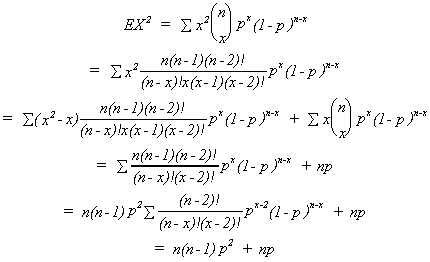

The binomial is of interest to us because we could use a set of independent
variables to model the probability of success. In practice we usually do this by assuming
that the underlying data generating process is logistic or normal because they are more
flexible.
2. POISSON
Suppose we wish to find the probability distribution of the number of auto
accidents at a particular intersection during a period of 1 week.
Divide the week into n subintervals so small that at most one accident could occur in any one interval with P(accident) > 0. Define
P(1 accident in a subinterval) =p
Let be the average value of the
random variable, number of accidents, observed over many intervals, say n, of the same
size. Then the probability of x accidents is
It can be proved that the Poisson distribution is a limiting case of the binomial.
Example: A machine producing widgets averages 1 bad in a production run of 100
parts. p = .01.
Suppose we produce n = 200. What is the probability of there being no defects?
Using the binomial

Using Poisson
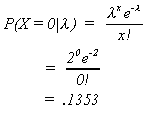
Poisson is a probability distribution satisfying the axioms of probability. We prove one of them here
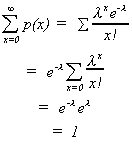
MEAN OF POISSON RANDOM VARIABLE

VARIANCE
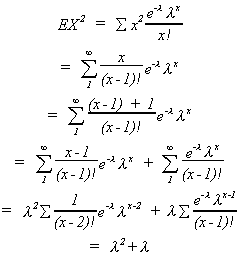
Since (EX)2 = l2, we know Var(X) = l.
The Poisson has many applications in economics and management science. The classic
paper on Poisson regression, in which the rate parameter is modeled by a set of
independent variables is Jorgensen. It has been used to model aggregate strike activity
and traffic accidents.
II.B. CONTINUOUS RANDOM VARIABLES
INTRODUCTION: A continuous random variable whose domain is any real number. It can
be on the open interval (-¥,¥)
or any sub-interval.
AXIOMS
1. 
2.
MEAN
VARIANCE
1. NORMAL DISTRIBUTION
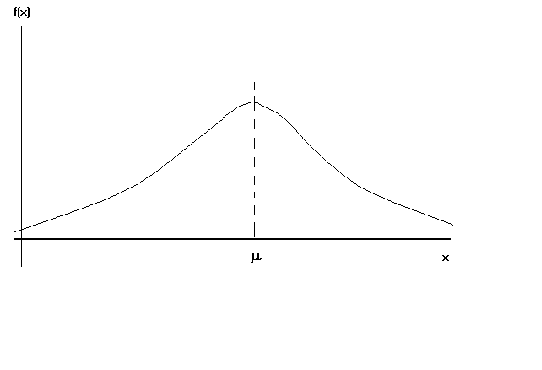
The density is given by
where = mean and
= variance of the random variable X. This could
be awkward to integrate by parts for every problem. Fortunately every normal random
variable can be transformed into one having a given mean and variance.
Let , then
Now let

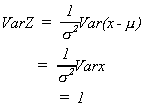
so we have transformed the normal random variable x into Z with = 0,
= 1. This means we only need to know how to do one specific integration.
Note
The normal is
1. symmetric
2. asymptotic to horizontal axis.
3. is neither platy- nor leptokurtic.
Click here to see what the normal distribution looks like.
Suppose

Needless to say, this is a difficult integration. Fortunately someone has gone to
the trouble of integrating and tabulating a N(0, 1) variable.
So note

we now have our question in terms of the tables.
Example: Hulk Hogan, former Olympic heavyweight wrestler, has agreed to meet a randomly selected SUMA wrestler. We know the following about such wrestlers
We also know that Hogan weighs 345 pounds. He wants to know the probability that the visiting SUMA is bigger than he
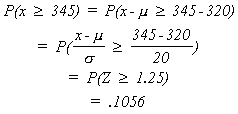
It should be noted that when n, the number of trials is large the binomial may be
approximated by the normal.
Example: Flip a penny 64 times
or
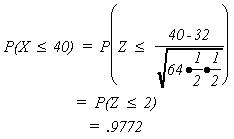
2. CHI-SQUARE DISTRIBUTION
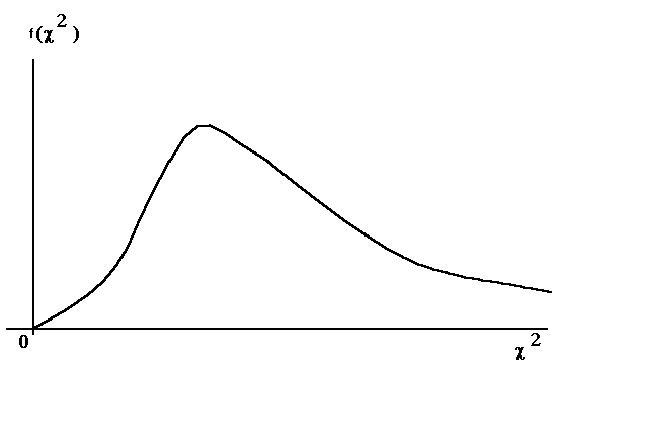
The chi square random variable is related to the normal distribution. Suppose we
observe a whole bunch of normal random variables that are independent of each other. Let
us select, randomly, ten
x1, x2, ... , x10
Transform them
Square these and add them up
where = 10
1. The number of degrees of freedom determines the shape of the distribution. As
it approaches a normal.
2.
3.
Example: You should be able to use a set of tables to see how these are done.
1.
2.
Suppose that we had constructed
and
Then y has a non-central chi square distribution. That is, it is more skewed than if we had used the proper construction. The non-centrality parameter is
The usual tables are for the central chi-square. In order to calculate
probabilities for a non-central distribution you would have to write an approximation
algorithm. Such algorithms can be found in Abramowitz and Stegun, Handbook of Mathematical
Functions, Dover Publications, New York, 1970.
II.C. CHEBYSHEV'S INEQUILITY AND LAWS OF LARGE NUMBERS
This section will be your first introduction to asymptotic theory. You will find
much more in a later section of the lecture notes.
Let us first state "An Inequality"
Let x be a non negative random variable and t be a positive number. We wish to
know the probability that the random variable will exceed t. We integrate the probability
density from t to infinity.
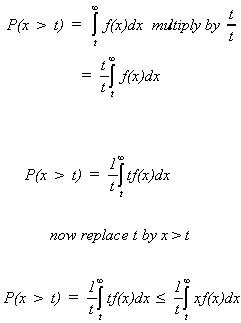
Let us add on another piece to the right side

so 
CHEBYSHEV'S INEQUALITY
Let x be a random variable with E(X) = and Var(X) =
then
Proof:
As in the previous theorem we have a non negative random variable and a positive number so that
since we can write
WEAK LAW OF LARGE NUMBERS
Let x1, x2, ... be independent and identically distributed random
variables with mean and variance
. Then for each positive number
we can write
Proof: Using Chebyshev we can say that

We know, using the rules of expectations,
Then
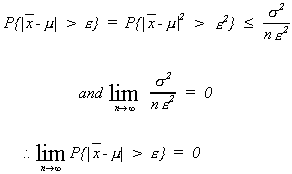
We have just shown that the sample mean is a consistent
estimator of the population mean.
CENTRAL LIMIT THEOREM
Suppose x1, x2, ... , xn
are iid random variables.
Let
Then mean of Sn is and
Now transform Sn to get
which has a mean of zero and a variance of one. Now,

In layman's terms, the theorem states the following:
The distribution of the means of random
samples taken from a population having mean
and finite variance
approaches the normal
distribution with mean
and variance
as the sample size, say n, becomes large.
This will prove to be very useful. Its importance lies in the fact that regardless
of the distribution of the random variable x, the distribution of will be normal. This allows us to not only engage in hypothesis
testing, but parametric hypothesis testing.